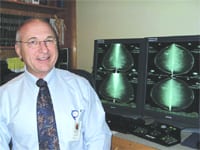Wired for Wellness A Guide to Some of the Latest Trends in Personal Health Technology
There was a time when the only medical technology we used to keep ourselves healthy was a thermometer.
Those days are over, however, and personal technology in particular has taken on a new role in the wellness market. More than ever, new products are being introduced to the marketplace that tout a wide array of health benefits, from assisting with weight management to promoting better sleep, or preventing illness down the road.
This month, The Healthcare News looks at some of the emerging trends in this sector, and some of its newest product offerings.
Calories In, Calories Out

Losing weight and keeping it off is arguably the most pressing health issue facing Americans today, and new technology can be used effectively to help keep dieters on track.
Following on the heels of the pedometer, a largely successful and accessible gadget of late that records a wearer’s number of footsteps each day, calorie meters are receiving more attention as a similar device that provides even more relevant information for people watching their weight.
Just about the size of a pedometer, calorie meters like those made by Caltrac measure calorie burn. Every two minutes, the unit calculates how many calories have been expended throughout the day, even while resting, or during a specific activity such as running, walking, or even doing housework.
After entering weight, height, age, and gender, the wearer clips the calorie meter onto a belt or waistband. The Caltrac includes an LCD readout that displays calories burned, as well as navigates through special settings for cycling, stair climbing, elliptical trainers, and weight training.
What’s more, calorie counters are relatively inexpensive; the Caltrac retails for about $55, and less expensive models from other manufacturers are available; www.muscledynamics.net
Save the Weight
Electronic devices like calorie meters help dieters monitor their progress at all times during the day, but sometimes, more sophisticated planning and recording is necessary.
Professionals pressed for time already benefit from organizational software including Microsoft Outlook programs and time-management software such as Base Camp, so perhaps it’s not surprising that weight management now has its own computer-based program as well.
Weight-By-Date Pro, developed by Quite Healthy Technologies of Apex, N.C., includes a weight-loss calendar to track progress; a food diary that automatically provides calorie, protein, and carbohydrate amounts, among other variables; a health and fitness journal that tracks body measurements; and a series of charts that illustrate progress on several levels.
The program can also be synchronized with a mobile phone or PDA for convenience. Both CD-ROM packages and Web-based downloads of Weight-By-Date start at $37.
Quite Healthy is also developing a second software program for tracking health statistics, this one tailored for diabetics. DiabeteSense will provide a computer-based program to help control blood glucose levels and weight, and potentially prevent long-term problems; www.quitehealthy.com
Gaming to Glory?

Following that move toward round-the-clock fitness, formerly stationary types of recreation such as video games are also throwing their controllers into the ring.
We’ve all seen the lines that form around the holidays in front of electronics retailers and big-box stores once the latest and greatest gaming system has hit the shelves.
Few can doubt the popularity of video games, but they have come under scrutiny in recent years due to rising obesity rates among Americans, especially children, and the role television- and computer-based activities might play in that trend.
One of the industry’s largest contenders, however, Japanese manufacturer Nintendo, has been touting the health benefits of its latest invention, the Wii gaming console.
While the company makes no specific medical claims regarding the Wii, the benefits of video games that require physical activity, such as the popular arcade game Dance Dance Revolution (DDR), have already been noticed by health experts and the media, even spawning a new term: exergaming.
Indeed, Wired magazine recently reported that a 180-pound man can burn about 842 calories lifting weights for an hour and a half, and 900 calories playing DDR for one hour.
The Wii (found at most major retailers for about $200) uses specially designed controllers called ‘Wiimotes’ that players use to mimic the movements of various activities and sports, such as tennis, golf, boxing, or fishing, and can also burn calories; 30 minutes of Wii Boxing, for instance, burns about 250 calories, the same amount as a half-hour of aerobics.
Building on the existing success of the console and to expand its reach into other markets, including older players and women, Nintendo has been focusing much of its marketing and sales efforts on this health-related angle. Currently, the company is mulling the possibility of expanding the Wii’s equipment offerings to include biofeedback options, such as blood pressure and pulse rate monitors, and is adding new games that require even more movement; www.wii.com
Water, Water Everywhere

Personal monitoring goes well beyond the weight-loss realm, however. Devices like calorie and heart-rate meters are indeed helping many people battle the bulge, but another gadget now in development promises to keep an electronic eye on another important fitness variable.
The HydrAlert, created by MIT medical device start-up Hemetrics, monitors a body’s hydration level. It’s a hand-held product that measures the concentration of sodium ion in the blood, which is known to help detect dehydration as well as overhydration. Similar to a glucose meter, the HydrAlert requires that a small drop of blood be placed on a test strip and inserted into the device. The units are being marketed to health care professionals, nursing homes, and medical centers currently, and prices at about $800; mitinnovations.com
Time Is on Your Side

Further, many people are looking to make their fitness regimens just one part of a better quality of life overall, which includes restful sleep and a healthy immune system. One intriguing product, dubbed the ‘feel-good watch,’ is attempting to help achieve that peace of mind.
High-end watchmaker Phillip Stein has entered the healthcare market with its acclaimed line of Teslar watches, retailing for between $500 and $2,000. Teslar timepieces come equipped with a special chip designed to block electromagnetic fields emanated by cell phones, computers, and other electronic devices. The technology has many fans, including Oprah Winfrey, who recently gave the watches her ‘One of Oprah’s Favorite Things’ seal of approval, and its developers claim that Teslar can lead to a stronger immune system, more restful sleep, and increased energy levels; www.phillipstein.com
To Sleep, Perchance to Dream
Another gadget that touts its benefits as a sleep aide is the Verilux TwiLight Ultra Blue Light Sleep Therapy System, which was conceived in part using NASA-developed research.
The light (about $80) uses ‘flicker elimination technology’ to provide an even, soft glow approximating moonlight. Blue light is thought to improve sleep patterns by re-setting Circadian rhythms when turned on by the bedside for 30 minutes; www.veriluxstore.com

Air Apparent
The TwiLight is also small and light enough to travel with, and more people travel globally today than ever before.
But a restful night’s sleep is always difficult with a sinus infection or a cold, and a greater number of people are also getting acquainted with one of air-travel’s most formidable foes — illnesses caused by poor air quality in airplane cabins.
The FDA has certified a portable air filter called the Plane Clean, which mounts to the small air vent above your seat and removes about 99.5{06cf2b9696b159f874511d23dbc893eb1ac83014175ed30550cfff22781411e5} of allergens, bacteria, and viruses.
The filter is more effective than oral immune-system boosters and less conspicuous than masks, and is also inexpensive — the units are available at Target and Amazon.com for about $20.
On the Home Front

It’s not just on walkabout that worries about preventing illness will crop up, though. A suite of products are now targeting the cleanliness and health of the home, too — inventions like Halo Technologies’ Ultraviolet Vacuum, which retails for $399 and up.
Ultraviolet light can be used to clean domestically because it kills mold, dust mites, bacteria, and even viruses. As carpets generally cover more than 70{06cf2b9696b159f874511d23dbc893eb1ac83014175ed30550cfff22781411e5} of floor space in U.S. homes and are rarely, if ever, disinfected, they contain the highest concentration of germs and allergens in the home.
With that in mind, and with asthma and allergy rates on the rise among American children in particular, Halo created the first ultraviolet vacuum on the market; www.halocompany.com
A Brave New World
With such a wide gamut of wellness-related products to choose from, consumers today are hard-pressed to find any reason not to incorporate technological tools into their own health regimens.
The days of the thermometer as the only complicated medical gizmo in the home are far behind us, but more important could be what lies ahead, as people become more hooked into their health and wellness.
Be sure to pick up the August issue of The Healthcare News for a guide to some of the cutting-edge technology being used today in the hospital setting.



Comments are closed.